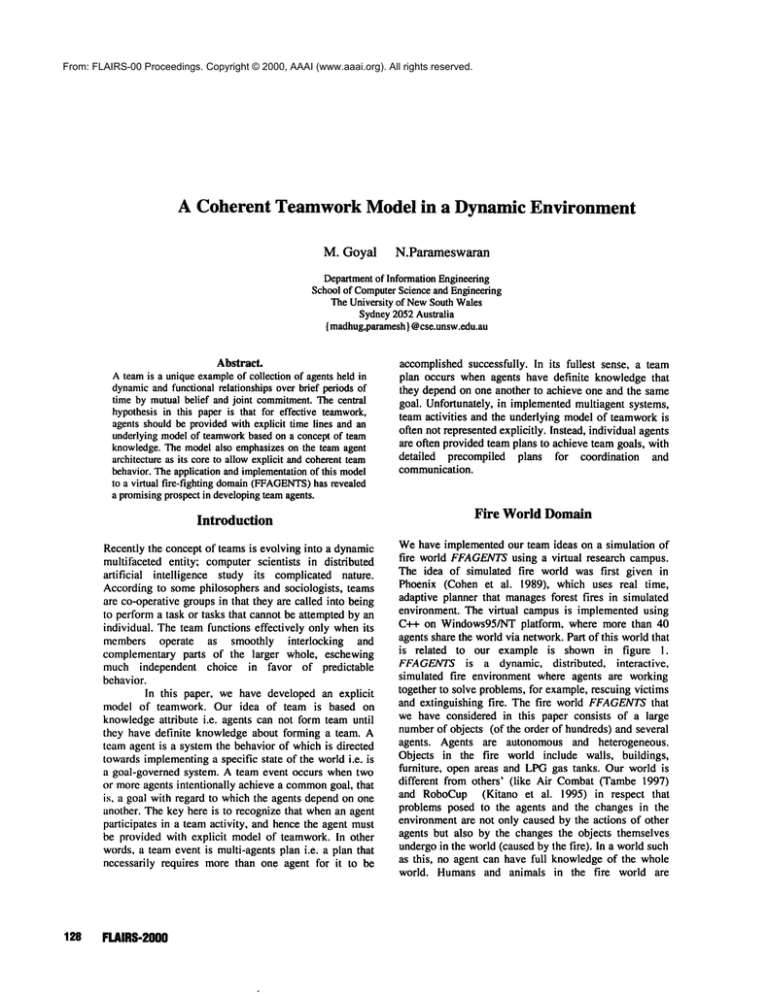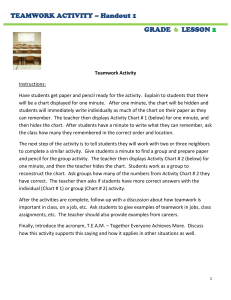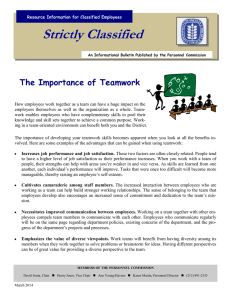
From: FLAIRS-00 Proceedings. Copyright © 2000, AAAI (www.aaai.org). All rights reserved.
A Coherent TeamworkModel in a Dynamic Environment
M. Goyal N.Parameswaran
Departmentof InformationEngineering
School of ComputerScienceand Engineering
TheUniversity of NewSouthWales
Sydney2052Australia
{ madhug,paramesh
} @cse.unsw.edu.au
Abstract.
A team is a uniqueexampleof collection of agents held in
dynamicand functional relationships over brief periods of
time by mutual belief and joint commitment.The central
hypothesis in this paper is that for effective teamwork,
agents shouldbe providedwith explicit time lines and an
underlying modelof teamworkbased on a concept of team
knowledge.The modelalso emphasizeson the team agent
architecture as its core to allowexplicit andcoherentteam
behavior.Theapplication and implementation
of this model
to a virtual fire-fighting domain(FFAGENTS)
has revealed
a promisingprospectin developingteamagents.
Introduction
Recently the concept of teams is evolving into a dynamic
multifaceted entity; computer scientists in distributed
artificial
intelligence study its complicated nature.
According to somephilosophers and sociologists, teams
are co-operative groups in that they are called into being
to perform a task or tasks that cannot be attempted by an
individual. The team functions effectively only whenits
members operate as smoothly interlocking
and
complementary parts of the larger whole, eschewing
much independent choice in favor of predictable
behavior.
In this paper, we have developed an explicit
model of teamwork. Our idea of team is based on
knowledgeattribute i.e. agents can not form team until
they have definite knowledge about forming a team. A
team agent is a system the behavior of which is directed
towards implementinga specific state of the world i.e. is
a goal-governed system. A team event occurs when two
or more agents intentionally achieve a commongoal, that
is, a goal with regard to which the agents dependon one
another. The key here is to recognize that whenan agent
participates in a team activity, and hence the agent must
be provided with explicit model of teamwork, in other
words, a team event is multi-agents plan i.e. a plan that
necessarily requires more than one agent for it to be
128
FLAIRS-2000
accomplished successfully. In its fullest sense, a team
plan occurs when agents have definite knowledge that
they depend on one another to achieve one and the same
goal. Unfortunately, in implementedmultiagent systems,
team activities and the underlying model of teamworkis
often not represented explicitly. Instead, individual agents
are often provided team plans to achieve team goals, with
detailed precompiled plans for coordination
and
communication.
Fire World Domain
Wehave implemented our team ideas on a simulation of
fire world FFAGENTS
using a virtual research campus.
The idea of simulated fire world was first given in
Phoenix (Cohen et al. 1989), which uses real time,
adaptive planner that managesforest fires in simulated
environment. The virtual campus is implemented using
C++ on Windows95/NTplatform, where more than 40
agents share the worldvia network. Part of this world that
is related to our example is shown in figure 1.
FFAGENTSis a dynamic, distributed,
interactive,
simulated fire environment where agents are working
together to solve problems, for example, rescuing victims
and extinguishing fire. The fire world FFAGENTS
that
we have considered in this paper consists of a large
numberof objects (of the order of hundreds) and several
agents. Agents are autonomous and heterogeneous.
Objects in the fire world include walls, buildings,
furniture, open areas and LPGgas tanks. Our world is
different from others’ (like Air Combat (Tambe 1997)
and RoboCup (Kitano et al. 1995) in respect that
problems posed to the agents and the changes in the
environment are not only caused by the actions of other
agents but also by the changes the objects themselves
undergoin the world (caused by the fire), in a world such
as this, no agent can have full knowledgeof the whole
world. Humans and animals in the fire world are
modelled as autonomousand heterogeneous agents.
Thus, in our team model, each agent deliberately
Whilethe animalsrun awayfrom fire instinctively, the
supportsthe team. Everyagent in teamis "conscious"of
fire fighters can tackle andextinguishfire andthe victims
its ownrole in the teamactivity.
escape from fire in an intelligent fashion. Anagent
respondsto fire at different levels. Atthe lowerlevel, the
Achieving the monitoring behaviour requires two
agent burnslike any object, such as chair. At the higher
components:
Tomonitorany activity x, we thus need,
level, the agent reacts to fire by quickly performing
1. a modelof x
actions, generating goals and achieving goals through
2. a set of rules that satisfy the monitoringbehaviourof
the agent.
plan execution. This world contains all the significant
features of a dynamicenvironmentand thus serves as a
suitable domainfor our team agents. Agentsoperatingin
Accordingto us, the behaviorof agents in a teamcan be
the domainface a high level of uncertaintycausedby the
further dividedinto followingcategories:
fire. Agentsin the fire domaindo not face the real time
- Teamdefinition issues (DEFt)
constraints as in other domains,wherecertain tasks have
- Teamactivity itself (ctr)
to be finished within the certain time. However,because
- Attitude of teamagents towardsthe teamactivity(
of the hostile natureof the fire, there is strongmotivation
KT)
for an agent to completea givengoal as soonas possible.
- TeamReactiveissues(Rr)
- Teammaintenance issues(MNTr)
The teamdefinition issues contributes to the activities
agents do maintainthe teamdefinition. Theteamactivity
consists of the actual activity the agentsperformto solve
a teamgoal e.g. in our domainthe teamactivities are put
out fire, movechemicals etc. The attitude of team
towardsthe teamcontributes to the communication
issues
and operationsdoneon the teamactivity itself. It means
teamagents shouldbe able to answerquestionsregarding
the teame.g.
Figure1. Part of Fire World
Explicit
Model of Teamwork
Theproblemof modelingthe activity of teamof agents is
a combination of two sub problems: the first is the
modelingof the teamitself (Tambe97) and the second
the modellingof the teamactivity (Groszand Kraus96).
In this paper, wehave attemptedto modelboth the team
andits activities on a structurecalled timeline structure
(TLS).Instead of relying on joint intentions framework
(Cohen and Levesque 91), we argue that team is
attribute of participating agents’ i.e. each agent is
individually awareof team, and "consciously"supports
the teamas an abstract entity by performingappropriate
teamrelated activities. In particular, eachagent performs
the tbUowing
types of activities:
Teamtask related activities: this relates to
achievingtasks assignedto the agent by the team.
Teamdefinition activities: this relates to the
activities that the agent has to performin orderto
implement the definition of team from the
individualagent’sviewpoint.
Monitoring
activities: Thisrelates to activities the
agent performsfor monitoringits ownas well as
other agent’s activities in order to dynamically
control its commitmentsto the above type of
activities.
Are youin a team?
Howmanymembersare there in the team?
Whatis the teamtask or teamgoal?
Whatis the teamstate?
The operations done on the team activity includes
modify,update, suspendthe teamactivity etc. It means
the agents shouldbe able to update, modifysuspendtheir
team plan if the situation in a dynamicenvironment
changes. The team reactive issues revolve around the
survivalneedsof the teamagenti.e. whenfire is large the
team will run awayfrom the fire. The team maintenance
behaviorrequires whatthe agent should do so that team
does not disintegrate. For example,whena companyof
firefighters put out fire together, each teammember
is
well awareof the teamactivity - each individual is not
merelyputting out fire on its own,while coordinating
with others. In order to maintainthe team, eachagent in
the teamwill remainwithin a safe distancefromthe other
members
of the team.
TeamAgentArchitecture
The behaviour of agents in a team is a reasonably
consistent pattern basedon the dynamic
integration of the
sum total of an agent’s knowledge,beliefs, goals,
intentions and plans. The agent architecture shownin
figure 2 is designed for intelligent agents executing
cooperativeteamgoals in a multi-agentenvironment.To
workcooperativelywith other agents, a teamagent must
INTELLIGENT
AGENTS 129
have a self-model (Physical and Mental State of agent)
and modelof other agent. In our architecture, we propose
four modules for a team agent, team belief module
(TBM), team plan module (TPM), team goal module
(TGM),and time line and intention module (TLIM).
team belief module(TBM)consists of facts that the agent
believes to be true about the world. Beliefs in general
include beliefs about goals, plans, beliefs about other
agents’ beliefs and intentions. A maturing team moves
toward becominga social system in the sense that it is a
group of people whointeract with an accepted structure
in order to achieve a goal. Thus a major function of team
beliefs is to provide the necessary backgroundknowledge
in team plan execution, so that a flexible, efficient and
~Vodd Mo&Iand Modol
Y
I
C
T.’mnBelief
[
Moduk (TBM)]
TcmnGoal/vlodsdc
TGM
W
I T©muPlmmcr ~,
Goal Generater
R
L
D
Goal Pool
I.~’¢1of Abstragtion
Tl
T2 .........
Tn
) Temns’sTLS
Goal Selector
Fig. 2. TeamAgentArchitecture
Fig. 3. TimeLine Structure
coherent teamwork. In team goal module (TGM)module,
the goal generator uses different types of rules to generate
the different goals from goal pool. The team plan module
(TPM)specifies how a goal can be decomposedinto team
activities. Theset of such plans for an agent is also called
the plan library. A team can execute a plan only if all its
membershave the same plan. The purpose of a time line
and intention module (TLIM) is to schedule the team
activities. All the team activities are scheduled in a
particular sequence or pattern. A team agent picks up the
most recent goal/activity, expandsit dynamicallyinto low
level details and inserts theminto time line for execution.
Whenagents form a team, problems emerge regarding the
representation and execution of actions. Thus the time
line module helps to formalize complexteam plans into
individual team actions.
However, for agents residing in a large and highly
dynamicworld, the time line structure enumerating all
basic actions becomestoo long and is difficult to reason
with and maintain. Moreover,the agent often has only a
partial knowledgeof the world and its action execution
capabilities, and it maynot always be possible to fully
developtime lines to their finest details. Agentsoperating
in real-world applications must be able to notice and
respond to unplanned situations. The range of possible
events in the world is vast, while an agent is constrained
by limited resources and limited computational speed.
Becauseof these limitations, the agent is unable to build
complete plans within arbitrary deadlines. Thus in most
of real world applications, a team usually has only a
partial plan at the initial stage because of dynamicsand
unpredictability of agent’s environments. To deal with
such reactive situations, we suggest incorporation of IFTHENrules in the partial plan (Ambros-lngerson and
Steel 1988). This problem solving strategy provides
framework that allows interleaving
planning and
execution. Thus replanning maybe triggered in response
to unexpectedevents. Thusthe planning in real world is a
dynamicprocess. A team plan specifies a series of team
activities that the agent needs to perform in order to
achieve or maintain the team goal. The team activities
within the team plan must eventually rest on actions of
individual member’sor subgroup; the collaborative team
Representing Plans for TeamActivity
Our team-planning module is combination of both
reactive and deliberative planning. The dynamic nature
of domainand issues of replanning forces the agents to
plan reactively. Also the idea of team agents making
decision requires a greater focus on deliberation than
reactivity. The more focus on deliberation has led us to
130
drawsubstantially from the classical planning literature.
Our team planner uses hierarchical task-decomposition
technique
for the team task decomposition
by
decomposingabstract tasks into a set of sub team actions.
A team plan is a way or approach that the team agents
choose and agree on to do their task and achieve their
goal. It is both an abstract structure/recipe and a set of
complex mental attitudes (Grosz and Kraus 1996)(Rao
1997). Thus team tasks may be abstract or primitive. We
represent plans as Time Line Structures
(TLS).
Traditionally,
time line structures are viewed as a
collection of primitive actions, which are temporally
ordered. Planninginvolves the construction of a time line,
which gives detail of sequential list of actions, which
guide from an initial state to final desired state. Suppose
there are two agents (A and B) in a team. The time line
structure for the team as well as of the agents is shownin
figure 4. Theteam action Tt is further divided two actions
a] and b]. Similarly team action T2is divided into actions
a2 and b2. The team action Tn consists of future actions an
and bn, which are shown dotted
because of
unpredictability of the environment.
FLAIRS-2000
actions are usually highly abstract and consist of actions
for individual membersor subgroups (Figure 3). Thus
solution to a team problemcan be specified in three ways:
!: Plan-Execute Method: It involves deriving a plan, and
executing the plan. This approach is used when the
world is reasonably stable during planning and plans
execution.
l i Behavioral Method: It involves executing a set of
rules. This approach is used when the world is
changingtoo fast to do planning.
I Z Combination Method: It involves
adapting a
combination of the above two methods.
Whena new fire is reported, an agent retrieves an
appropriate plan from the plan library and places it on the
timeline. Information about the resources and sensory
input are stored in the world modeland is used to help the
team agent to select the appropriate plan. At any time
during this process, sensory data can trigger reactive
actions, which will cause the team planner to modify its
plan (such as moving away from the fire ahead)
incorporation of some rules. Following are some of the
rules that specify the team activity at the higher level
(stated in the goal generator module).
TeamSense (MediumFire)
[TeamClearObj
ects (MediumFire),
TeamCh
oose (SubFire)
, TeamPutOut
(Subfire)
TeamSense
[TeamChoose
(Ai)
( Smal iFire)
AgentExec
->
(Ai,
SmallFire)
TeamSense
(NoFire)
[ TeamTerminate
TeamGoOut]
->
(AI iActivity,
Fig. 4. : Solutionfor puttingout fire (Behavioralmethod)
The right hand side of each rule is in the form of a plan.
This plan must be loaded on the TLSand executed. But
each action the plan is actually a complexgoal. Weneed
to specify solution for each goal the waywe did for the
goal TeamPutOut (fire). The plan based solution for
TeamPutOut(subfire) for a team of two agents (each has
the capability of putting out fire in one square) will be
like shownin figure 5.
i. TeamPlan= [ TeamPutOut
tOut (sq3, sq4 ) ...]
Implementation
Wehave developed implementation and experimentation
in fire fighting in virtual research campusto verify our
ideas about the team problem solving. Here we describe
the approach taken to the modeling of teams and team
behavior a part of the modelingof fire fighting missions.
FFAGENTSis a dynamic, distributed,
interactive,
simulated fire environment where agents are working
together to solve problems, for example, rescuing victims
and extinguishing the fire. Our experiments concentrate
on the evaluation of the significant level of coordination
among team members. Agents based on our approach in
our domaincontain 40 plans and 1000 rules, with roughly
20%dedicated to our explicit model of teamwork. In our
experiment, a team of fire-fighting agents (FF-Team)
consists of one companyofficer, and two sub teams of
two fire fighters each. The companyofficer is the leader
of the team and consequently makesdecisions for tactical
deployment while assisting and supervising individual
membersof the company. The fire fighters perform all
the tasks necessary to put out fire and to control an
emergency situation. These tasks may include operating
the hose-line and performing search and rescue
operations. Whena fire is reported, a goal called "PutOut-Fire" is generated by the goal generator. The goal
generator then retrieves a corresponding plan from the
plan library and passes it to the time line manager. The
time line managerloads the appropriate plan on the time
line. There are five kinds of actions that can be
differentiated by their effects on the timeline. The team
time line contains the actions for team definition (DEFT),
team maintenance (MNTT),team reactivity (RT),
activity (aT) itself and team knowledge (KT) or
attitude.
Figure 6 illustrates
that our current
implementation provides significant
insight of the
activities the team does in order to achieve a particular
goal.
10
%OF 8O
ACTIONS
fi]
TEA~f 6~
TL~
K(T©mn)
40
( sql, sq2 ) , TeamPu
\
2. TeamExecute (TeamPlan)
Fig.5. Solution for putting out fire
method)
% A ,-"
MNT(Tcmn)
50 100 1.50 ~ 250 300 350 400 TIME
(Plan based
Fig. 6. Percentof teamactivities in team’stimelinestructure
INTELLIGENT
AGENTS131
Related Work
One of the most popular and contemporaneous
approaches of teams is that, the joint action by a team
does not depend on simultaneous and individual actions,
but it is based on team goals, mutual beliefs and joint
commitment (Cohen and Levesque 1991). Other popular
theories in this area are based on SharedPlan (Grosz and
Kraus 1996) and joint responsibility (Jennings 1995).
Teamwork is becoming increasingly
popular in
multiagent environments, such as, real-world battlefield
simulator (Tambe 1997), industrial control (Jennings
1995), and synthetic RoboCupsoccer (Kitano et al.
1997). According to the theory of SharedPlan, in which
the team membersare required not only to be committed
to the success of the team achieving the goal, but also
follow the team plan when doing so. However, joint
intention and SharedPlanalone are not sufficient for the
successful execution of the team plan, but a team should
have attributes like team maintenance, team attitude and
team knowledge. In applications, teamwork model (the
STEAM
system) has been successfully applied in the
virtual military training and RoboCup soccer game
domains (Kitano et al. 1997). The agents in STEAM
system seem to be more homogenousin terms of their
capabilities. The hierarchy of operators /strategies is
known to every agent in the system, including the
opponents. There is little chance for agents to deviate
from the standard, well-defined team strategy. Nick
Jennings applied agent teamwork in the industrial
electricity managementsystem (Jennings 1995) using
framework called joint responsibility based on joint
commitmentto a joint goal, and joint commitmentto a
commonrecipe. These two types of joint commitments(a
variation of joint intention) are claimed necessary
because different actions are taken when the joint
commitmentsare dropped. Howeverjoint responsibility
model seems to be limited to a two level hierarchy of a
joint team goal and a joint team plan, which is different
from our approach.
Conclusion
Concludingour work in this paper, we explicitly present a
complete teamwork model, which is used to coordinate
agent activities and solve problems in unpredictable,
hostile and dynamic environments. In the multiagent
problem solving an explicit representation of teams is
required. The agents must knowwhat they are doing and
correspondingly behave reactively and deliberatively.
According to us, the team is a behaviour that an agent
maintains towards some of its fellow agents. Wehave
given a definition of team, which provides flexible,
coherent and collaborative teamwork in a multi-agent
dynamic world. It is believed that in a dynamic domain
where agents are autonomousand heterogeneous, there is
a need for timeline structures, which contain both team
plans and team rules. In addition, there is also the
necessity of introducing individual plans at certain level
of abstraction into the team plan. Weargue that because
132
FLAIRS-mOO
of the dependencyof the agents’ actions and the risk of
plan failure, the team planner should replan or modify
team plan according to different team behaviours.
References
1. Ambros-Ingerson,J.A., and Steel, S 1988. Integrating
Planning, Execution and Monitoring. In Proceedings of
the National Conferenceon Artificial Intelligence.
2. Cohen, P.R.; Greenberg, M.L.; Hart, D.M.; and Howe,
A.E. 1989. Trial by fire: Understanding the design
requirements for agents in complex environments. A!
Magazine,10(3).
3. Cohen, P.R., and Levesque, H.J. 1991.Teamwork.
Nous, 35.
4. Grosz, B.J., and Kraus, S. Collaborative Plans for
Complex Group Actions. Artificial
Intelligence
86
(1996), pp269-357, 1996.
5. Jennings, N 1995. Controlling Cooperative problem
solving in Industrial Multi-agent Systems using joint
intentions, Artificial Intelligence.
6. Kitano, H.; Asada, M.; Kuniyoshi, Y.; Noda, I.;
Osawa,E. 1995. Robocup:The robot world cup initiative.
In Proceedings of the
IJCAb95 Workshop on
Entertainment and Al/Alife.
7. Rao, A.S. 1997. A unified View of Plans as recipes.
Technical Report 77. The Australian
Artificial
Intelligence Institute.
8. Tambe, M. 1997. Agent architectures for flexible,
practical teamwork. In Proceedings of the National
Conferenceon Artificial Intelligence (AAAI).





